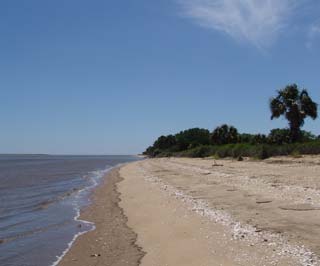Marine - Front Beach
 South Carolina's front beaches, generally broad and flat, fringe the state’s 190-mile shore line, virtually uninterrupted from North Carolina to Georgetown, and from there, southward along the state’s 32 barrier islands and on into Georgia.
South Carolina's front beaches, generally broad and flat, fringe the state’s 190-mile shore line, virtually uninterrupted from North Carolina to Georgetown, and from there, southward along the state’s 32 barrier islands and on into Georgia.
These beaches contain three zones: the undulating dunes, the flat intertidal beach (littoral zone) and the subtidal beach. On severely eroded beaches dunes may disappear as the littoral zone pushes into the maritime forest which typically backs the front beach.
On more stable beaches, multiple rows of dunes often cover many acres and sometimes exceed ten feet in height. Strong offshore winds and storm surges often push high tides up into the dune field.
The gradual slope of South Carolina beaches produces gentle surf as approaching waves break over the shallow bottom, dissipating much of their energy before reaching the beach.
South Carolina's twice daily tides of four to seven feet in height alternately inundate and then expose the dynamic intertidal zone, which, depending on the slope of the shore, may extend more than 100 yards from low tide to high tide.
At low tide, the surface sand dries and temperature soars on sunny days, forcing animals to move out with the tide or to burrow into the sand. This rapid, regular change from hot to cold, wet to dry makes the intertidal zone inhospitable to all but the most well adapted creatures such as mole crabs, ghost shrimp, surf clams, and a variety of tube worms. Many of these creatures develop large populations because of the abundance of food washed in on each tide.
The intertidal beach supports few animal species, but a great variety fishes and invertebrates living just below the low tide mark move freely back and forth, taking advantage of the shifting tides to prey on beach organisms or to pick up organic debris. Some of these animals may become stranded as the tide retreats.
Offshore predatory fishes take advantage of the daily access to beach and sub-tidal prey species. These fishes include many popular recreational species such as red drum, black drum, Spanish mackerel, spotted seatrout, bluefish, flounder, spot, whiting (southern kingfish), pompano, and several types of sharks.
